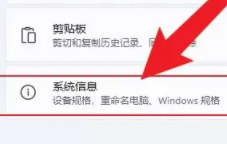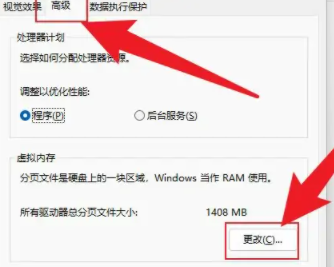The best method to set up Win114G memory and virtual memory
Virtual memory can be set when our computer has insufficient memory. After the setting is completed, it can help us free up computer space, which is very convenient. If the computer is below 4g, it is recommended to set 2-4g of memory.
How to set the best virtual memory for Win114G memory:
Answer: 2-4G
Generally speaking, if the computer memory is less than 4g, the best memory setting is 2-4g.
If it is 8g, the memory can be around 4-13G. If it exceeds 8g, it is recommended to set 8g.

How to set virtual memory in win11:
1. First, we click Settings.
2. Then click System.

3. Find the system information in the system.

4. Then click "Advanced System Settings".

5. Then click "Settings".

6. Then find Advanced and click Change.

7. Finally, open the top part and then you can customize the size.

The above is the detailed content of The best method to set up Win114G memory and virtual memory. For more information, please follow other related articles on the PHP Chinese website!

Hot AI Tools

Undresser.AI Undress
AI-powered app for creating realistic nude photos

AI Clothes Remover
Online AI tool for removing clothes from photos.

Undress AI Tool
Undress images for free

Clothoff.io
AI clothes remover

AI Hentai Generator
Generate AI Hentai for free.

Hot Article

Hot Tools

Notepad++7.3.1
Easy-to-use and free code editor

SublimeText3 Chinese version
Chinese version, very easy to use

Zend Studio 13.0.1
Powerful PHP integrated development environment

Dreamweaver CS6
Visual web development tools

SublimeText3 Mac version
God-level code editing software (SublimeText3)

Hot Topics
 1359
1359
 52
52
 C++ object layout is aligned with memory to optimize memory usage efficiency
Jun 05, 2024 pm 01:02 PM
C++ object layout is aligned with memory to optimize memory usage efficiency
Jun 05, 2024 pm 01:02 PM
C++ object layout and memory alignment optimize memory usage efficiency: Object layout: data members are stored in the order of declaration, optimizing space utilization. Memory alignment: Data is aligned in memory to improve access speed. The alignas keyword specifies custom alignment, such as a 64-byte aligned CacheLine structure, to improve cache line access efficiency.
 Extensions and advanced techniques for C++ function memory allocation and destruction
Apr 22, 2024 pm 05:21 PM
Extensions and advanced techniques for C++ function memory allocation and destruction
Apr 22, 2024 pm 05:21 PM
C++ function memory management provides extensions and advanced technologies, including: Custom allocator: allows users to define their own memory allocation strategies. placementnew and placementdelete: used when objects need to be allocated to specific memory locations. Advanced technologies: memory pools, smart pointers, and RAII to reduce memory leaks, improve performance, and simplify code.
 Best practices for C++ function memory allocation and destruction in large code bases
Apr 22, 2024 am 11:09 AM
Best practices for C++ function memory allocation and destruction in large code bases
Apr 22, 2024 am 11:09 AM
Best practices for C++ function memory allocation and destruction include: using local variables for static memory allocation. Use smart pointers for dynamic memory allocation. Memory is allocated in the constructor and destroyed in the destructor. Use custom memory managers for complex memory scenarios. Use exception handling to clean up resources and ensure that allocated memory is released when exceptions occur.
 C++ Memory Management: Custom Memory Allocator
May 03, 2024 pm 02:39 PM
C++ Memory Management: Custom Memory Allocator
May 03, 2024 pm 02:39 PM
Custom memory allocators in C++ allow developers to adjust memory allocation behavior according to needs. Creating a custom allocator requires inheriting std::allocator and rewriting the allocate() and deallocate() functions. Practical examples include: improving performance, optimizing memory usage, and implementing specific behaviors. When using it, you need to pay attention to avoid freeing memory, manage memory alignment, and perform benchmark tests.
 Challenges and countermeasures of C++ memory management in multi-threaded environment?
Jun 05, 2024 pm 01:08 PM
Challenges and countermeasures of C++ memory management in multi-threaded environment?
Jun 05, 2024 pm 01:08 PM
In a multi-threaded environment, C++ memory management faces the following challenges: data races, deadlocks, and memory leaks. Countermeasures include: 1. Use synchronization mechanisms, such as mutexes and atomic variables; 2. Use lock-free data structures; 3. Use smart pointers; 4. (Optional) implement garbage collection.
 Reference counting mechanism in C++ memory management
Jun 01, 2024 pm 08:07 PM
Reference counting mechanism in C++ memory management
Jun 01, 2024 pm 08:07 PM
The reference counting mechanism is used in C++ memory management to track object references and automatically release unused memory. This technology maintains a reference counter for each object, and the counter increases and decreases when references are added or removed. When the counter drops to 0, the object is released without manual management. However, circular references can cause memory leaks, and maintaining reference counters increases overhead.
 How to manage memory usage in PHP functions?
Apr 26, 2024 pm 12:12 PM
How to manage memory usage in PHP functions?
Apr 26, 2024 pm 12:12 PM
To manage memory usage in PHP functions: avoid declaring unnecessary variables; use lightweight data structures; release unused variables; optimize string processing; limit function parameters; optimize loops and conditions, such as avoiding infinite loops and using indexed arrays .
 Best practices for memory management of golang functions
Apr 26, 2024 pm 05:33 PM
Best practices for memory management of golang functions
Apr 26, 2024 pm 05:33 PM
Memory management best practices in Go include: avoiding manual allocation/freeing of memory (using a garbage collector); using memory pools to improve performance when objects are frequently created/destroyed; using reference counting to track the number of references to shared data; using synchronized memory pools sync.Pool safely manages objects in concurrent scenarios.




